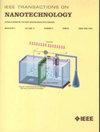NeuroSOFM-Classifier:利用连续实时无监督聚类进行分类的基于纳米级 FeFET 的低功耗神经形态架构
IF 2.1
4区 工程技术
Q3 ENGINEERING, ELECTRICAL & ELECTRONIC
引用次数: 0
摘要
有监督的机器学习技术正在成为数据分析领域备受关注的主题。然而,当前实现方法对内存带宽的要求较高、标记数据稀缺以及许多应用中的动态环境都阻碍了监督机器学习技术的实现。在这项工作中,我们提出了一种神经形态架构,利用纳米级铁电场效应晶体管(FeFET)和互补金属氧化物半导体(CMOS)技术来实现自组织特征图算法,从而制造出一种半监督式 NeuroSOFM 分类器。最佳匹配输入 (BMI) 识别器电路允许使用极少量的标记样本为 NeuroSOFM-Classifier 中的每个硬件神经元提供有监督的类标签。然后,NeuroSOFM-Classifier 架构可用于对新数据进行实时推理或分类。该 NeuroSOFM-Classifier 仅使用 2% 的标记数据进行训练,就能对 COVID-19 患者胸部 X 光片进行分类,平均准确率高达 83%。本文章由计算机程序翻译,如有差异,请以英文原文为准。
NeuroSOFM-Classifier: Nanoscale FeFETs Based Low Power Neuromorphic Architecture for Classification Using Continuous Real-Time Unsupervised Clustering
Supervised machine learning techniques are becoming subject of significant interest in data analysis. However, the high memory bandwidth requirement of current implementations, scarcity of labeled data, and dynamic environments in many applications prevent implementation of supervised machine learning techniques. In this work, we propose a neuromorphic architecture implementing the self-organizing feature map algorithm using nanoscale ferroelectric field-effect transistors (FeFETs) and complementary metal-oxide-semiconductor (CMOS) technology to produce a semi-supervised NeuroSOFM-Classifier. A best matching input (BMI) identifier circuit allows for very few labeled samples to be used to provide supervised class labels for each hardware neuron in the NeuroSOFM-Classifier. The NeuroSOFM-Classifier architecture can then be used to inference or classify the new data in real-time. This NeuroSOFM-Classifier, trained on just 2% of the labeled data, is capable of classifying COVID-19 patient chest x-rays with an average accuracy of 83%.
求助全文
通过发布文献求助,成功后即可免费获取论文全文。
去求助
来源期刊

IEEE Transactions on Nanotechnology
工程技术-材料科学:综合
CiteScore
4.80
自引率
8.30%
发文量
74
审稿时长
8.3 months
期刊介绍:
The IEEE Transactions on Nanotechnology is devoted to the publication of manuscripts of archival value in the general area of nanotechnology, which is rapidly emerging as one of the fastest growing and most promising new technological developments for the next generation and beyond.
 求助内容:
求助内容: 应助结果提醒方式:
应助结果提醒方式:


